Enterprise Content Management (ECM): What It Is & Best Systems in 2021
An enterprise content management system is similar to a content management system, but the difference is that an ECM manages internal company documents whereas a CMS manages web content. Emails, business documents, onboarding materials, training videos, invoices, Excel spreadsheets, scanned images, and much more can be managed within an enterprise content management system.
A key characteristic of a great ECM is its ability to scale as a company grows. To do this, ECM systems combine a robust collection of technologies, workflows, and strategies that a company can use to digitally manage its information. They also typically support integrations with other tools and systems that can help make enterprise content easier for teams to access at any point in the content lifecycle.
Why Enterprise Content Management
The benefits of an enterprise content management likely seem obvious, but there’s more than meets the eye with this type of system.
Your operations team will appreciate having an ECM because they reduce operational costs. How? When your teams can automate tasks in an ECM that are usually done manually, labor hours spent on these tasks can be focused on other parts of the business that are more important.
Another benefit of an ECM is shared knowledge. When was the last time someone asked you about that end-of-year marketing retrospective spreadsheet from two years ago? How much time did you spend looking for it before you admitted it disappeared into the blackhole that is your database? Not only were you unable to find that information, your team now has a gap in their information about the marketing team which limits their knowledge about past successes and challenges on the team.
Don’t feel bad, it happens to all of us pre-ECM. An organized and streamlined ECM can prevent that from happening in the future.
How an ECM Works
Most ECM systems combine or support integrations with a variety of software tools to help organize and manage unstructured content. These integrations include:
- Big data tools for storing and analyzing unstructured and structured data
- Analytics, data mining, dashboards, and reporting tools to help companies make sense of their structured and unstructured data
- Data integration tools for combining data from disparate sources into a single application
- Information management tools for tracking structured and unstructured enterprise data throughout its lifecycle
- Search and indexing tools for retrieving information from unstructured data files such as documents, web pages, and photos
Ideally, your ECM system will provide enough built-in functionality and flexibility to help you automate repetitive tasks like data entry. You’ll be able to identify bottlenecks, streamline processes, and create workflows across the enterprise. By doing so, teams can work collaboratively, increase their productivity, and reach business goals.
Below we’ll look at some of the best ECM systems that can help you achieve collaboration and productivity goals.
The Challenges of Starting an ECM System
Enterprise content management systems can solve a lot of problems within your business, but they aren’t perfect. ECMs come with their fair share of challenges that can be overcome with a bit of creativity. Two of these common challenges include compliance and poor solution onboarding.
Depending on the type of business you work with, you might be required to maintain hard copies of certain documents which don’t have a place in an ECM. Promissory notes, titles and deeds, tax records, and a business license are a few examples of documents that can’t be stored in an ECM system and will need to have their own secure place in a physical location.
Migrating all of your data into an enterprise content management system is not an easy task. Many businesses fail the first time they launch an ECM effort. A lack of communication is usually the culprit. If teams are not asked what they need from an ECM system, then the solution will likely be a poor fit for those teams.
Moreover, teams may not receive adequate training on the ECM system if the need for the system wasn’t communicated clearly in the planning stage. Communicating the need for an ECM, soliciting input from all functional teams, and receiving feedback on team adoption of the ECM can prevent and curtail these issues.
Best Enterprise Content Management Systems
- CMS Hub
- Laserfiche
- Shopify Plus
- Xerox DocuShare
- Zoho Docs
- eFileCabinet
- IBM FileNet Content Manager
- Magento Commerce
- DocStar ECM
- Adobe Experience Manager
Below we’ll take a look at the features and pricing of each of these ECM systems.
Please note that some companies did not include pricing information on their product pages. In that case, there’s pricing information included from a third-party site, denoted by an asterisk. If you’re looking for exact pricing information, connect with the company on their website for an accurate quote.
G2 Rating: 4.5 out of 5 stars
With CMS Hub Enterprise, you have complete control over your content and users on up to two brand domains. You can restrict your HubSpot-hosted pages and blog posts to members only. You can configure the CDN to control how external visitors access your HubSpot-hosted content for an additional layer of protection. You can even build out content on HubSpot and deliver it to visitors on a non-HubSpot-hosted domain or subdirectory.
Internally, you can give your teams different permissions for blog posts, pages, emails, forms, CTAs, lists, or workflows based on their role, region, and other demographics, so they can see and edit only what’s relevant to them. You can also track down what changes were made to HubSpot content, including pages, modules, blogs, images, CTAs, and more, and by whom.

Source
You can organize these users on multiple levels based on team, region, business unit, brand, or any other dimension, to reflect your businesses’ hierarchical structure. And you can assign these users to single sign-on credentials to simplify the log in process while enhancing security and maintaining control over who has access to the HubSpot platform.
Using a public API, you can build custom tracking dashboards for your HubSpot-hosted content to monitor its performance. This will also enable you to not only measure how the site is performing over time, but also track down errors reported by your customers, identify areas of the site that are slow or high-traffic, and see the site’s overall uptime in any given period. Code alerts will also help you identify infrastructure or design bugs that could cause a page to fail, slow down your site, or disrupt the customer experience with errors in syntax, HubL, or missing tags.
Finally, you can use serverless functions powered by AWS Lambda to add interactive elements, like event registrations, guest books, and dynamic calculators, to your HubSpot-hosted content, without needing to configure an external server, SSL certificate, or data transfer process.
All of these features come on top of the Professional tier as well, which includes website themes, responsive drag-and-drop editors, SEO recommendations, multi-language content creation, contact attribution report builder, and 24/7 monitoring and threat detection. That means you can manage your enterprise content in the same place you create it.
Pricing: $900 per month
G2 Rating: 4.6 out of 5 stars
Laserfiche is designed to help your enterprise in three major areas: process automation, content management, and platform services.
With Laserfiche, you can digitally capture, secure, and organize all paper, digital, and mobile content across the enterprise, including documents, images, videos and more.
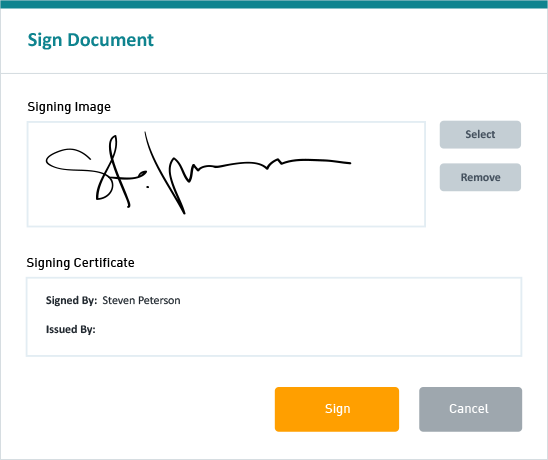
Source
You can collaborate with people in and outside organization while setting guidelines for record management to ensure compliance and security across the enterprise. You can eliminate manual processes with AI-powered workflows and e-forms. And, using the built-in reporting and analytics tools, you can identify inefficiencies and hidden opportunities.
Combined, these features can help you improve productivity, provide a better user experience, and optimize your operations.
You can also integrate your Enterprise Resource Planning (ERP) system, CRM, and other applications using robotic process automation and tools that don’t require coding. Integrating these tools can help fill in the gaps in Laserfiche’s product for managing your customers and business better.
Pricing: $60 per user per month*
G2 Rating: 4.5 out of 5 stars
Shopify Plus is designed to help enterprise-level businesses in ecommerce provide seamless shopping experiences to their customers.
With Shopify’s easy-to-use store editor, you can add augmented reality, video, and 3D on product pages to replicate in-person retail experiences. You can fully customize your checkout with personalized discounts and shipping rates to make it faster and more engaging for all your customers. Or you can allow customers to skip the cart and buy directly from the product page with their preferred payment method using one-tap accelerated checkout.

Source
You can also release promotions across multiple channels, automate discounts for specific products or entire product lines, and schedule sales, product releases, and restocks.
Apps including Launchpad, Shopify Flow, and Scripts, as well as third-party integrations will enable you to automate customization and extend the overall functionality of your site. You can, for example, plug in your CMS to the Shopify Plus platform, which will help you generate and manage content as you do sales. You can plug in other business tools and systems as well, like your CRM and ERP, to have all the tools you need on one platform.
Since Shopify Plus takes care of the technical aspects of running an online store at the enterprise level, you can focus on retail.
Pricing: Minimum of $2,000 per month. Once you pass a certain threshold of monthly revenue, you’ll pay a percentage of that revenue.*
G2 Rating: 4.0 out of 5 stars
Xerox DocuShare combines enterprise content management, process automation, and file sharing under one central platform.
Users can digitize, store, and secure critical business data with automated processes and workflows. Collaboration is a key feature DocuShare supports with their easy-to-use search feature. DocuShare is available as an on-premise software or as a cloud-based solution.
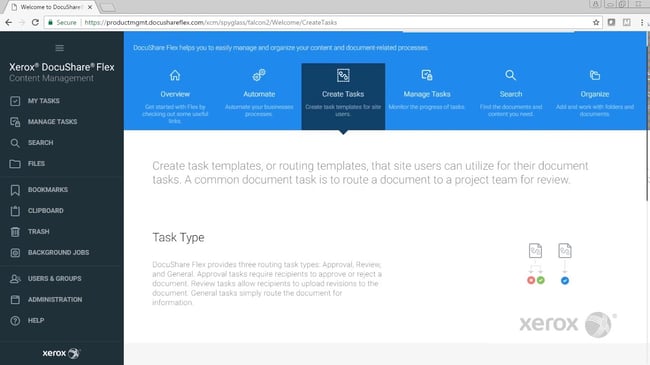
Source
Whether your team chooses to access from a mobile device or a desktop, Xerox DocuShare supports your business with robust tools to automate processes and support digital collaboration.
Pricing: Contact Xerox for pricing information
G2 Rating: 4.4 out of 5 stars
If you’re looking for file management for teams and individuals, Zoho Docs is a smart solution. This ECM offers a secure and collaborative workspace where all of your data, documents, and information are available in real-time to anyone who needs them.
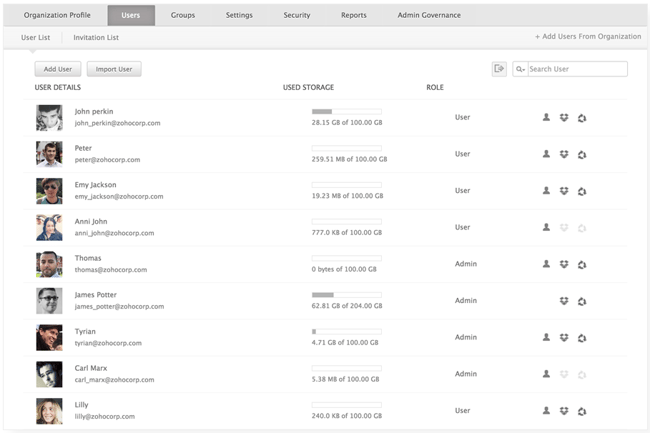
Source
Included in this enterprise content management system is an office suite complete with spreadsheets, slideshows, and word processing documents. Your team will also have access to a secure file cabinet where they can collaborate and innovate all in a secure cloud-based environment.
Pricing: Temporary free trial for teams
G2 Rating: 4.4 out of 5 stars
Remember earlier when we talked about misplacing that marketing spreadsheet? Those days are long gone with eFileCabinet. This platform offers a feature called Rubex that helps you locate documents that probably ended up in the wrong folder.
You can reimagine your workday by automating workflows and processes that take up hours per week that could be spent on other projects. Like many of the options in this list, eFileCabinet is compatible with both mobile and desktop devices in an app or browser-based interface.
Source
ECM systems aren’t one size fits all, so your business can choose from several types of solutions including finance, HR, Accounting, and more.
Pricing: From $55 per month
7. IBM FileNet Content Manager
G2 Rating: 4.0 out of 5 stars
With IBM FileNet Content Manager, you can manage all your content from any source. The platform leverages AI to deliver deep insights from unstructured content like videos. You can also share your content with external users without compromising consistency, organization, or security. You can also extract insights from content like invoices, videos and other unstructured documents.
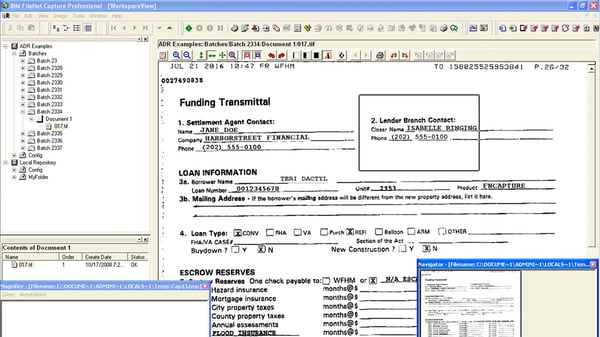
Source
IBM FileNet Content Manger can be integrated with a CMS, CRM, and other applications in and outside of the IBM product suite. This can allow you to create a microsite, keep track of your visitors, and fulfill other business needs. Keep in mind that integrations require you to use coding tools and modern GraphQL APIs, and those parts don’t always work great together.
While this solution excels in terms of security, classification, organization, and encryption, it is not easy to use, extend, or upgrade — even for developers with specialized knowledge.
Pricing: Contact IBM for pricing information
G2 Rating: 3.9 out of 5 stars
Magento Commerce is a hosted ecommerce platform like Shopify Plus. It offers many of the same features, including instant purchasing, customer segmentation and personalization, and automatic inventory management.
What sets Magento apart is its more robust content creation features. In addition to a drag-and-drop page builder, it also comes with content staging and preview tools so your teams can easily create, preview, schedule, and update content. This content can be tailored to customers based on properties such as their location, gender, order history, lifetime purchase value, wish list items, and more to provide them with personalized shopping experiences on desktop and mobile. You can also set automated rules to determine which products to present as up-sells, cross-sells, and related products to different customer segments.
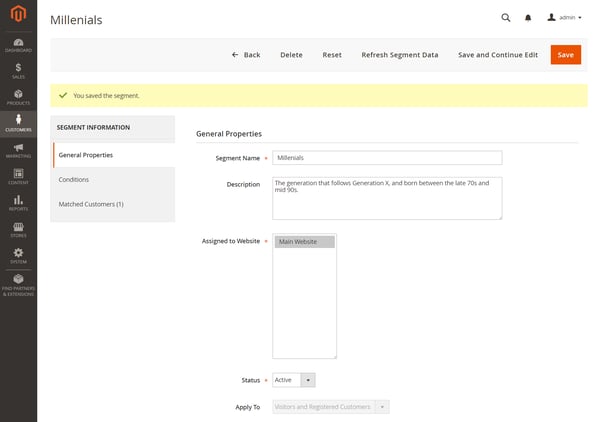
Source
While these features can help boost your conversion rates, they can be difficult to find and configure since Magento’s dashboard is less intuitive than Shopify Plus and other ECM systems. For example, there are over 5,000 extensions available to download but they aren’t plug-and-play tools that can be activated and deactivated. Instead, they have to be manually coded into your Magento Commerce API. That means it will likely take longer to learn the platform and set up your store.
Pricing: approximately $2,000 per month*
G2 Rating: 3.7 out of 5 stars
Designed for midsize organizations of 100-1,000+ employees, DocStar ECM helps businesses grow with intelligent data capture, workflow, and retrieval.
DocStar allows you to capture, store, and manage your paper documents as well as any native file type— including .wav, .pdf, .jpg, .html, and more— electronically from any location, on any device. You can create and process electronic forms, assign user permissions, search your entire content repository by keyword, and create custom workflows with drag-and-drop technology.
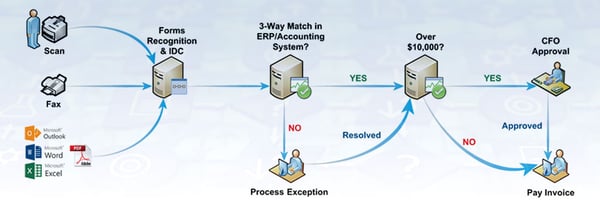
Source
Together, these features will help you reduce errors, improve collaboration, and increase productivity while adhering to corporate or regulatory compliance requirements.
Since its primary focus is data, it appeals to enterprise companies in the healthcare, manufacturing, education, government, banking, and insurance industry. But DocStar can integrate with your existing software applications, including your ERP and CRM, to help you better manage your users and customers in addition to your data.
Pricing: Contact DocStar for pricing information
G2 Rating: 3.7 out of 5 stars
Adobe Experience Manager is designed to combine digital asset management with the power of a content management system.
With Adobe Experience Manager, you can create and re-use digital assets (known as “content and experience fragments”) across different channels and devices to streamline your content creation. These fragments — combined with data integrations, communications management, and advanced targeting and customization features — will enable you to deliver personalized experiences to your visitors.
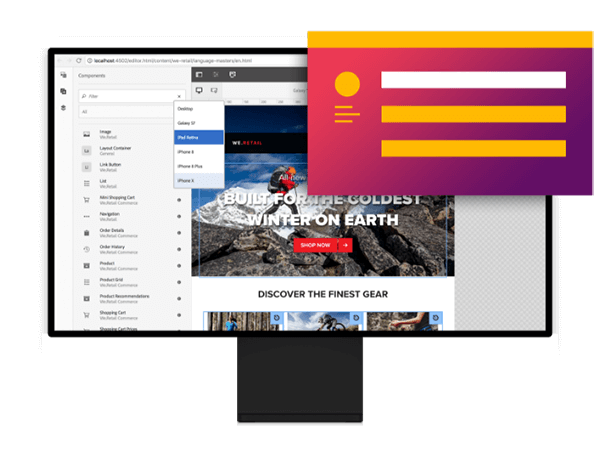
Source
You can also use AI to automate tagging, workflows, and content distribution so that your teams work better and faster together. Finally, with Adobe’s modular architecture, you never have to plan for product updates or worry about downtime. The platform is designed to auto-scale within seconds so you stay at peak performance.
Pricing: $2 million annually*
Managing and Storing Your Content Better
Any of the ECM systems above will help you find, manage, store, and use all your data in one place. To pick the solution that will help you make better business decisions, make sure its capabilities align with your enterprise needs and goals. You might need a solution not only with business intelligence tools but website building, SEO, and development tools so you can maximize your digital efforts on an all-on-one platform.
Editor’s note: This post was originally published in April 2020 and has been updated for comprehensiveness.
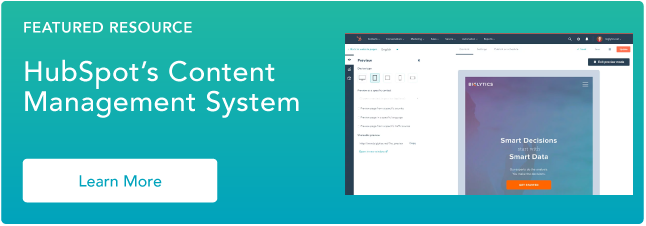










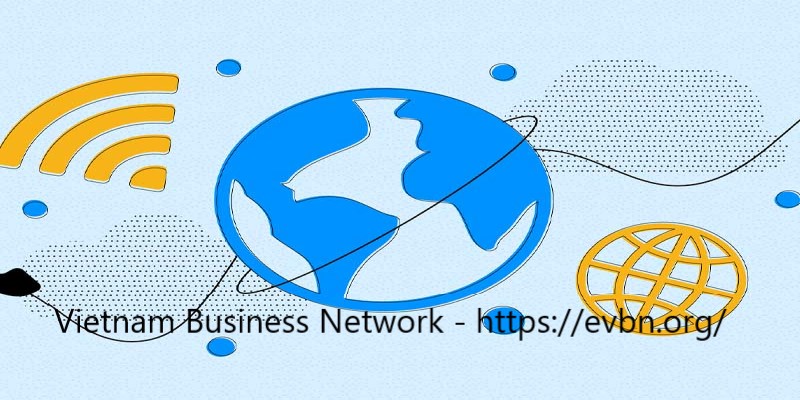






![Toni Kroos là ai? [ sự thật về tiểu sử đầy đủ Toni Kroos ]](https://evbn.org/wp-content/uploads/New-Project-6635-1671934592.jpg)


